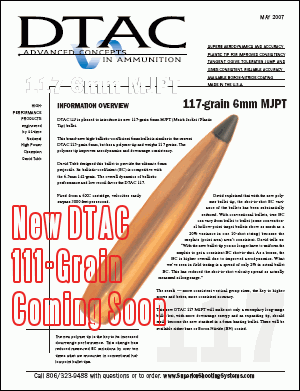Tubb Releases New 111-grain DTAC with Polymer Tip
David Tubb’s Superior Shooting Systems currently offers two high-BC bullets, both produced by Sierra Bullets to David’s specifications. The original DTAC is a 115-grainer with a normal match hollowpoint. The second bullet is a 117gr MJPT (Metal Jacket Plastic Tip), with a super-high 0.600 BC, confirmed by actual field tests.
We’ve just learned that DTAC plans, shortly after SHOT Show, to introduce a new, 110 or 111-grain 6mm bullet. Like the 117 MJPT, this will have a plastic tip. However, it should have a shorter base-to-ogive measurement than the 117-grainer. Hopefully the new bullet will be short enough to work in rifles throated for the 105s and 108s. David Tubb tells us that the bullet will be about .050″ shorter than the 117 and should need .020-.025 less throat. It should look like the 117 in the photo below, but with a shorter bearing surface, and a BC around 0.545:

David explained that the shot-to-shot BC variance of his bullets has been substantially reduced by the addition of the polymer bullet tip. With conventional bullets, true BC can vary from bullet to bullet because the meplats aren’t consistent. David tells us: “With the new bullet tip you no longer have to uniform the meplats to get a consistent BC shot-to-shot. As a bonus, the BC is higher overall due to improved aerodynamics. What we’ve seen in field testing is a spread of only 2% in actual bullet BC. This has reduced the measured shot-to-shot velocity spread at long range.”
Independent testing confirms many of David’s statements. A series of dual-chronograph tests done by Larry Bartholome and Ken Oehler showed that there IS significant bullet-to-bullet BC variance in most boxes of bullets. After testing over 30 brands of projectiles, Larry and Ken found the average extreme spread in BC was 0.019. On the other hand, plastic-tipped Hornady A-Max bullets showed the smallest BC variance of the samples tested. So maybe Tubb really is on to something here.
 Bullet pointing tests also suggest the importance of reducing bullet-to-bullet BC variance. Jason Baney’s recent work with the Whidden Pointing Die showed that the reduction of bullet meplat diameter (by pointing) produces a significant increase in effective BC–as demonstrated by less bullet drop at long range.
Bullet pointing tests also suggest the importance of reducing bullet-to-bullet BC variance. Jason Baney’s recent work with the Whidden Pointing Die showed that the reduction of bullet meplat diameter (by pointing) produces a significant increase in effective BC–as demonstrated by less bullet drop at long range.
CLICK HERE to Read Jason’s Bullet Pointing Analysis.


















I suspect this will be the replacement for the 117’s that have had some problems. I am cautiously optimistic on this new release and I assume that some of the issues that were present with the 117’s will be “nailed down” with this bullet. Personally after shooting the big 6mm bullets this past long range season I am of the opinion that 115 gr is about as big as a 6mm bore size can effectively handle and right on the edge as far as reliability, consistency and accuracy goes.
With everything in proper balance and just right you can get the 115’s running well, but they are not near as forgiving as the bullets down in the 105-108 gr range. A 110-111 gr 6mm bullet is kind of at the midway point between the 115’s and the 105-108 gr class of bullets. We’ll see how this will play out. I would love to try them when they come out.
Robert Whitley